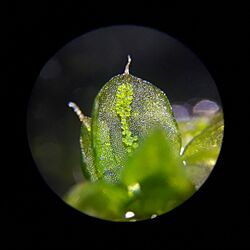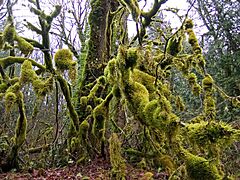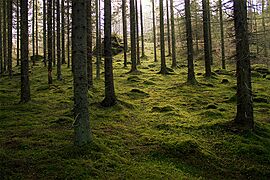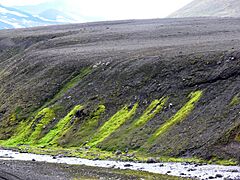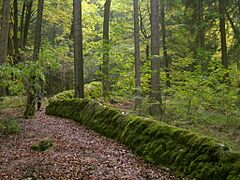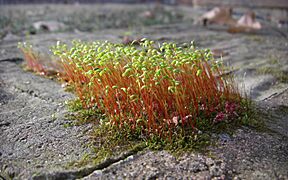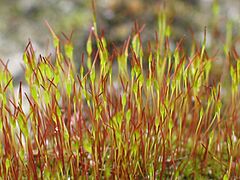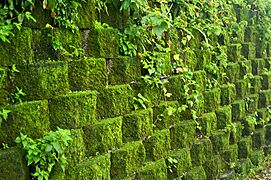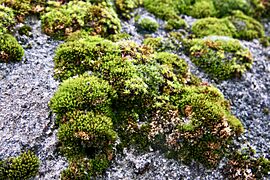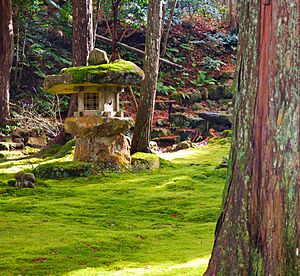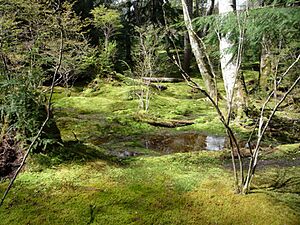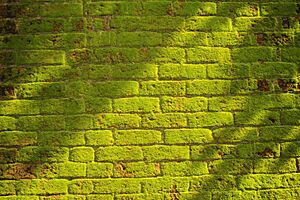Moss facts for kids
Quick facts for kids Moss |
|
|---|---|
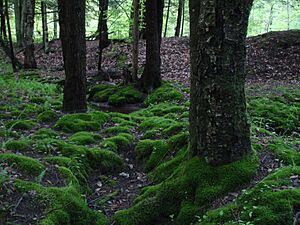 |
|
| Clumps of moss on the ground and base of trees in the Allegheny National Forest, Pennsylvania, United States | |
| Scientific classification |
|
| Kingdom: | Plantae |
| Clade: | Embryophytes |
| Division: | Bryophyta Schimp. sensu stricto |
| Classes | |
|
|
| Synonyms | |
|
|
Mosses are tiny, green plants that don't have flowers or seeds. They belong to a group called Bryophyta. Unlike most plants you know, mosses don't have a complex system of tubes (called vascular tissue) to carry water and food. Instead, they absorb water and nutrients right through their leaves.
Mosses usually grow in thick, soft clumps or mats, often in places that are damp or shady. Each moss plant has simple leaves, usually only one cell thick, attached to a small stem. Most mosses are very short, only about 0.2 to 10 centimeters (about 1 to 4 inches) tall. But some, like Dawsonia, can grow much taller, up to 50 centimeters (about 20 inches)! There are around 12,000 different kinds of mosses in the world.
People sometimes confuse mosses with other small plants like liverworts, hornworts, or even lichens. Lichens, for example, might look like moss, but they are actually a mix of fungi and algae, not true plants. Mosses are important for the environment, especially the kind called Sphagnum, which forms peat. They are also used for decorating and can help restore damaged habitats.
Contents
What Mosses Look Like
Mosses are small, soft plants that don't have woody stems. They get their food through a process called photosynthesis, using sunlight and carbon dioxide. Most mosses don't have roots like bigger plants. Instead, they have tiny, thread-like parts called rhizoids that help them stick to surfaces like soil, rocks, or tree bark. These rhizoids don't absorb water or nutrients.
Moss leaves are usually very simple, often just one layer of cells thick. Some have a thicker middle part, like a tiny vein. The edges of the leaves can be smooth or have small teeth.
Unlike flowering plants, mosses reproduce using spores, not seeds. Their spore-producing parts, called sporangia or capsules, grow on long, thin stalks. These stalks are usually not branched.
How Mosses Grow: Life Cycle
Most plants you know have two sets of chromosomes in their cells, like humans do. This is called being diploid. But mosses are special because most of their life is spent with only one set of chromosomes, which is called being haploid.
The moss life cycle begins with a tiny, haploid spore. When a spore lands in a good spot (like damp soil), it grows into a fuzzy, thread-like structure called a protonema. This protonema looks like a thin green mat. From this mat, the main moss plant, called a gametophore, starts to grow. This is the leafy part you usually see.
At the tips of the gametophore stems, special parts grow that are involved in reproduction. Female parts are called archegonia, and male parts are called antheridia. When there's enough water, like from rain, tiny sperm from the male parts swim to the female parts to fertilize them.
After fertilization, a new part starts to grow from the female plant. This is the sporophyte stage, which is diploid (has two sets of chromosomes). The sporophyte has a long stalk (called a seta) and a capsule on top. Inside the capsule, new spores are made. When the spores are ready, the capsule opens, and the wind carries the spores away to start the cycle again.
Some mosses have interesting ways to spread their spores. For example, Sphagnum moss can shoot its spores into the air with a burst of compressed air! Also, some tiny insects like springtails can help mosses reproduce by carrying sperm from male to female plants, similar to how bees pollinate flowers.
Mosses can also make new plants without spores or fertilization. They can grow small green pieces called gemmae on their leaves or branches. These gemmae can break off and grow into new, identical moss plants. This is a type of asexual reproduction.
Dwarf Males
In some moss species, the male plants are much smaller than the female plants. These "dwarf males" grow right on the female plant. This helps the mosses reproduce more easily because the male and female parts are very close together. Sometimes, the female plant even releases a special substance that keeps the male plants small.
Classification of Mosses
Mosses are part of a larger group called bryophytes, which also includes liverworts and hornworts. Scientists divide mosses into eight main groups, or classes:
- Takakiopsida
- Sphagnopsida
- Andreaeopsida
- Andreaeobryopsida
- Oedipodiopsida
- Polytrichopsida
- Tetraphidopsida
- Bryopsida
Most moss species belong to the class Bryopsida. The Sphagnopsida, also known as peat-mosses, are very important. They form huge, acidic bogs and are known for their ability to hold a lot of water.
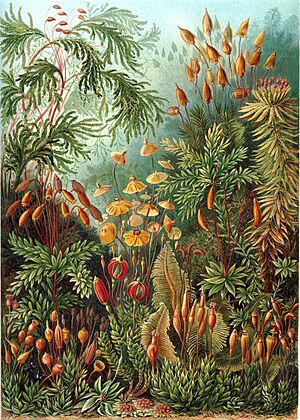
Where Mosses Live
Mosses need sunlight to make their food, just like other plants. They also need water, especially for reproduction. That's why you often find them in moist, shady places like forests or near streams. However, some mosses can live in sunny, dry areas like rocks in mountains or sand dunes.
Mosses can grow on many different surfaces: rocks, soil, tree trunks, and even concrete walls. Some mosses prefer certain types of trees or soil. Even though mosses often grow on trees, they are not parasites; they don't harm the tree.
You might see moss growing in cracks in city sidewalks or on roofs. Some types of moss are very good at living in cities. A few moss species even live completely underwater, like common water moss. Even these aquatic mosses need their spore capsules to be exposed to air to reproduce.
Many mosses can dry out completely and survive for months. When they get wet again, they can come back to life in just a few hours!
In the Northern Hemisphere, you might notice that moss often grows more thickly on the north side of trees and rocks. This is because the north side gets less direct sunlight, so it stays damper. In the Southern Hemisphere, the opposite would be true. However, in very cool, humid places, moss can grow all around trees and rocks because there's enough moisture everywhere.
Growing Moss
Sometimes people consider moss a weed in their grass lawns, but in Japanese gardens, moss is often grown on purpose. It's thought to make a garden feel calm, old, and peaceful. Moss is also used in bonsai to cover the soil and make the miniature trees look older.
It can be tricky to grow moss from scratch because different mosses need specific amounts of light, humidity, and soil type. However, if a surface is porous and holds moisture well, like brick or rough concrete, moss spores carried by the wind will often start growing there naturally within a few years. People sometimes try to encourage moss growth by preparing surfaces with acidic liquids like buttermilk or yogurt, or by mixing moss samples with water and compost.
In places with cool, humid climates, like the Pacific Northwest in the United States, people sometimes create "moss lawns." These lawns don't need much mowing, fertilizing, or watering.
Green Roofs and Walls
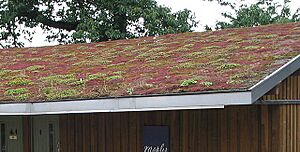
Mosses are sometimes used on "green roofs" and "green walls." They are a good choice because they are light, absorb a lot of water, don't need fertilizer, and can handle dry spells well. Since mosses don't have deep roots, they don't need much soil, which makes them lighter than other plants for roofs. Once they are established, they usually don't need to be watered.
Mossery
In the late 1800s, it became popular to collect mosses. People would build special "mosseries" in their gardens. These were usually wooden structures, open on the north side to keep them shady. Moss samples were placed in the cracks, and the whole structure was kept moist to help the moss grow.
Aquascaping
Many types of moss are used in aquascaping, which is like underwater gardening in aquariums. Aquatic mosses grow well with low light, nutrients, and heat. They also help keep the water healthy for fish.
Uses of Mosses
Traditional Uses
Long ago, people used mosses for many things.
- Bedding and Insulation: People like the Sámi and Native American tribes used moss for soft bedding. It was also used as insulation in homes, like between logs in cabins, and inside boots and mittens to keep warm. Even Ötzi the Iceman, a mummy from thousands of years ago, had moss in his boots!
- Absorbent Material: Dried mosses are very good at soaking up liquids. North American tribes used moss for diapers, wound dressings, and to absorb menstrual fluid.
- Food Preparation: Some tribes used moss to clean fish before drying it and to pack wet moss into ovens for steaming vegetables.
- Neanderthal Diet: Scientists have even found evidence that Neanderthals ate moss, along with pine nuts and mushrooms.
- Famine Food: In Finland, during times of famine, peat mosses were sometimes used to make bread.
Commercial Uses
- Floristry and Decoration: Moss gathered from the wild is used by florists and for home decorations.
- Peat: Decaying Sphagnum moss is the main part of peat. Peat is "mined" and used as a fuel, to improve garden soil, and even to smoke malt for making Scotch whisky.
- Plant Growing Medium: Sphagnum moss is harvested, dried, and used in nurseries as a medium for growing plants because it can hold up to 20 times its weight in water.
- Medical Use: During World War I, Sphagnum moss was used as a first-aid dressing for soldiers' wounds because it absorbs liquids quickly and is thought to have antibacterial properties.
- Fire Extinguishing: In the rural UK, a moss called Fontinalis antipyretica was traditionally used to put out fires because it grows in large amounts in slow-moving rivers and holds a lot of water. Its scientific name even means "against fire"!
- Christmas Decorations: In Mexico, moss is used as a Christmas decoration.
- Biotechnology: A specific moss, Physcomitrium patens, is used in biotechnology to study plant genes and even to produce medicines.
- Air Cleaning: Some cities have installed "City Trees," which are walls filled with moss. These moss walls are said to clean the air by absorbing pollution and producing oxygen, much like many regular trees.
See also
 In Spanish: Musgos para niños
In Spanish: Musgos para niños



